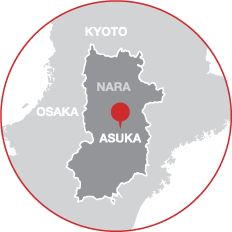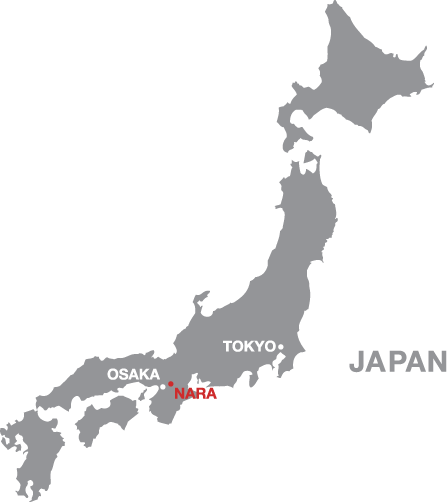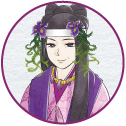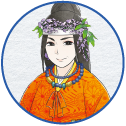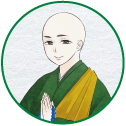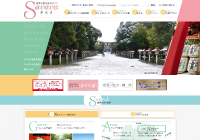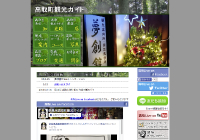Women in the Asuka Period
Empress Suiko
A regal woman with strong powers of communication
A gifted facilitator, East Asia’s first empress worked astutely with political leaders to enhance Japan’s regional status
As Buddhism was being introduced to Japan, there was lingering conflict over official recognition of the religion. The assassination of the emperor merely added to the chaos. In order to quell the disorder, Princess Nukatabe, empress consort to the former Emperor Bidatsu, acceded to the throne as Empress Suiko. In so doing, she became the first woman in the history of Japan—and East Asia—to hold this exalted rank.
Suiko deftly administered state affairs in close cooperation with two key figures: the brilliant Prince Umayato (known posthumously as Prince Shotoku) and Soga no Umako of the powerful Soga clan, a man with strong ties to Chinese and Korean immigrants. Suiko gave official recognition to Buddhism and promoted foreign culture brought to Japan by Buddhist monks from Baekje and Goguryeo.
Following the establishment of the Sui dynasty, Suiko sought to resume diplomatic relations with China and import that nation’s most advanced culture. Reports from her envoys made her keenly aware of how far Japan lagged behind China, so Suiko began a major overhaul of the political system in her realm. This included the adoption of the Twelve-Level Cap and Rank System that allowed for promotion based on individual talent and achievement, along with the Seventeen-Article Constitution that propounded the morals and virtues expected of the empress’s subjects and government officials.
Empress Suiko dispatched an envoy, Ono no Imoko, to deliver a letter to Sui Emperor Yang. It began, “From the sovereign of the land of the rising sun to the sovereign of the land of the setting sun, may good health be with you.” Although Yang found the letter presumptuous, he nevertheless reciprocated by sending his own envoy, Pei Shiqing, to Japan. Upon Shiqing’s return to China, he told Yang of the splendid sights he had seen in Japan, including the Oharidano-miya palace and the under-construction Asuka Daibutsu Buddha statue.
With Yang’s recognition of Japan as a sovereign state, Empress Suiko had succeeded in setting Japan on an equal footing with China. Under her reign, a continuing influx of new technologies from China brought further prosperity to Japan.
Empress Saimei
A fearless woman with progressive ideas
A free spirit who launched vital public works projects and took on every challenge without fear of taboos or criticism
After the death of Emperor Jomei, who had ascended to the throne thanks to the support of the Soga clan, Princess Takara, Jomei’s empress consort, ascended the throne under the name Empress Kogyoku. She was a mysterious empress who performed rituals such as rain-making. Her ascension to the throne should have averted an imperial succession feud, but the Soga clan attacked the family of the late Prince Umayato (Prince Shotoku), and the following year the Isshi Incident occurred, in which Prince Nakano-oe defeated the Soga clan. Immediately after this, Empress Kogyoku took responsibility for the incident and renounced the throne, something considered taboo at the time.
The next emperor was Kotoku, who moved the capital to Naniwa (present-day Osaka), initiating the Taika Reforms and centralizing imperial power. However, he was later abandoned by his underlings and died. As a result, Kogyoku once again ascended to the imperial throne, as Empress Saimei, at age 62. It was Japan’s first instance of someone becoming emperor or empress a second time.
Under a new organizational structure created by the Taika Reforms, she began in earnest to build a strong country, focusing her efforts on public works projects. Imperial palaces and a variety of other buildings were erected, and she even built a large-scale canal that brought widespread criticism for its excessiveness. She also dispatched ships to Tohoku (northeastern Japan) to expand her territory. She personally led her navy, traveling by sea to Kyushu (western Japan) with the intent of reviving the Baekje kingdom in Korea, which had been overthrown by the Tang dynasty of China and the Silla kingdom of Korea. But before she could lead the decisive battle, Empress Saimei died at age 68. The free-wheeling initiatives she took were most likely aimed at building a peaceful and secure nation.
Empress Jito
A politically savvy woman who was ahead of her times
A tenacious planner devoted to bringing her late husband’s dreams to fruition and to making her son successor to the throne
The girl who would grow up to become Empress Jito was born Princess Unono-sarara (or Sarara). A daughter of Emperor Tenchi, she entered into marriage with her father’s brother, Prince Oama. Several years later, a dispute erupted over who would succeed Emperor Tenchi to the throne. Prince Oama, sensing his life to be in danger, escaped to the seclusion of mountainous Yoshino. He was accompanied by only one of his consorts, Sarara, and their son, Prince Kusakabe. A year later, after defeating his nephew (Emperor Tenchi’s son) in the Jinshin War, Oama ascended to the throne as Emperor Tenmu.
Tenmu solidified his rule by building a political system that concentrated power in the hands of the emperor and the imperial family. He also established a system of appointing powerful clan members as bureaucrats. The emperor was also committed to building a new capital city. But soon after he had inspected the planned site and construction had begun, he passed away.
After the death of the emperor, Sarara did not immediately accede to the throne. Rather, she assumed responsibility for administrative affairs to ensure the eventual succession of her son Kusakabe. But when Kusakabe died three years later, Sarara took the throne as Empress Jito, naming as her successor Kusakabe’s son, the seven-year-old Prince Karu. Empress Jito saw that construction of the relocated capital was completed, thereby achieving her late husband’s dream. The new capital, known as Fujiwara-kyo, was an expansive city covering an area that included the three mountains of Yamato. Its streets were laid out in a grid pattern modeled after Chinese capital cities.
Prior to relocating the capital, Empress Jito finalized and put into force the Asuka Kiyomihara Code—a set of laws first compiled by Emperor Tenmu. Japan had gradually evolved into a state based on the ritsuryo legal system (ritsu being a criminal code and ryo an administrative code). This system replicated systems in place in the Chinese dynasties of Sui and Tang. Empress Jito thus accelerated the move towards a ritsuryo state system in Japan.
Nun Zenshin-ni
A pure-hearted woman with a charitable spirit
A fearless religious pioneer who bravely bore persecution and helped to foster Buddhism in Japan
The introduction of Buddhism to Japan gave rise to several decades of political strife between the Soga and Mononobe clans over official recognition of the religion. The Mononobe clan was especially aggrieved when Soga no Umako obtained a Buddhist statue from Baekje (Korea) and called for its veneration.
Umako sent his men to discover the whereabouts of Ebin, an ex-monk from Goguryeo who had lost his former status amid anti-Buddhist oppression. Having located Ebin, Umako asked him to instruct a bright and pure-hearted 11-year-old girl named Shima—the daughter of Chinese immigrant Shiba Tatto—in the ways of nunhood. She was to become Japan’s very first Buddhist priest.
Upon becoming a nun, Shima adopted the Buddhist name Zenshin-ni. At Umako’s request, Zenshin-ni guided two more girls into nunhood. The three nuns worshipped Umako’s Buddhist statue at a sanctum built inside his mansion. But when a plague broke out, the Mononobe clan seized the chance to blame it on the new religion, claiming it had incurred the wrath of the traditional Shinto deities.
Mononobe’s men raided Umako’s mansion, constrained the three nuns and stripped them of their clerical robes. Then they took the nuns to Tsubaichi and gave them a public whipping. Despite the pain and humiliation, Zenshin-ni never lost her faith in Buddhism and encouraged the other two nuns to remain steadfast and endure the ordeal.
At the age of 15, Zenshin-ni followed Umako’s suggestion and journeyed to Baekje to study Buddhist precepts. She traveled in the company of other nuns from her order on a trip that predated the first Japanese diplomatic mission to Sui China. After returning to Japan, Zenshin-ni devoted her life to propagating Buddhism, guiding many into Buddhist priesthood at Sakuraidera (Toyuradera) Temple.
Lady Nukata
An ambitious woman who balanced career and love
A spirited career woman who stole the show with her enchanting poems of passion and emotion
Lady Nukata served as a lady-in-waiting in the courts of Empress Saimei and Emperor Tenchi. She was a smart and multi-talented woman. Her poetry was so eloquent that the monarchs had her write poems on their behalf. And her dancing was so graceful that she was asked to dance accompaniments to important rituals. After giving birth to a daughter by Prince Oama (Emperor Tenmu), she was reappointed to a post in the court.
When Empress Saimei was heading for Kyushu (in western Japan) to organize a naval expedition to aid the kingdom of Baekje (in southwest Korea), Lady Nukata wrote this rousing poem on behalf of the empress. “At Nikitatsu / We have waited for the moon / Before boarding our boat; / Now the tide is in at last / Come, let’s go rowing!”*1 When the capital was relocated from Asuka to Omi-otsu during Emperor Tenchi’s reign, she gave voice to the poignancy of departure. “Do you dare to hide / Miwa Mountain in this way? / At least you, O clouds, / Should have greater heart than that: / What right have you to cover it?”*1
This famous poem is believed to be addressing her ex-husband, Prince Oama, at a banquet hosted by his brother Emperor Tenchi (to whom she was a consort at the time). “Going over the fields of murasaki grass / That shimmer crimson, / Going over the fields marked as imperial domain, / Will the guardian of the fields not see you / As you wave your sleeves at me?”*2 Prince Oama responded with the following: “If I despised you, who are as beautiful / As the murasaki grass, / Would I be longing for you like this, / Though you are another man’s wife?”*2
Prince Nakano-oe (Emperor Tenchi) wrote this poem about the three Yamato mountains (Kaguyama, Unebiyama, and Miminashiyama), which are likened to two men and a woman. “Mount Kagu strove with Mount Miminashi / For the love of Mount Unebi. / Such is love since the age of the gods; / As it was thus in the early days, / So people strive for spouses even now.”*3 This poem suggests a love triangle involving the princess and the two princes, but today the truth remains a mystery.
Many people today see Lady Nukata as a woman who lived for love. She expressed her emotions deftly through poetry, and she is now considered without doubt one of the greatest poets of her time.
*1 Translation by Edwin A. Cranston
*2 Translation by Ian Hideo Levy
*3 Translation by Nippon Gakujutsu Shinkokai



